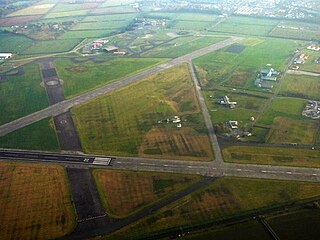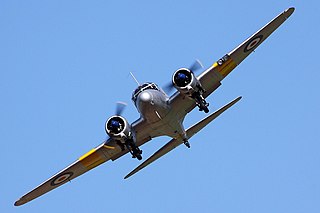
Joint Helicopter Command Flying Station Aldergrove, also known as simply JHC FS Aldergrove, is a British military base located 4.4 miles (7.1 km) south of Antrim, Northern Ireland and 18 miles (29 km) northwest of Belfast, and adjoins Belfast International Airport. It is sometimes referred to simply as Aldergrove which is the name of a nearby hamlet.

Royal Air Force Tangmere or more simply RAF Tangmere is a former Royal Air Force station located in Tangmere, England, famous for its role in the Battle of Britain.

Royal Naval Air Station Lee-on-Solent,, is a former Royal Naval Air Station located near Lee-on-the-Solent in Hampshire, approximately 4 miles (6.44 km) west of Portsmouth, on the coast of the Solent.

The Sembawang Air Base is a military airbase of the Republic of Singapore Air Force (RSAF) located at Sembawang, in the northern part of Singapore. The base motto is Swift and Resolute.

Tain Air Weapons Range is a Ministry of Defence air weapons range on the Dornoch Firth near Tain in Scotland. Royal Air Force aircrews from RAF Lossiemouth are trained in air weaponry on the range, along with NATO aircrew.

Royal Air Force Catterick or RAF Catterick is a former Royal Air Force airfield located near Catterick, North Yorkshire in England. It is located alongside the A6055 road on the outskirts of Catterick Village.

Royal Air Force Detling, or more simply RAF Detling, is a former Royal Air Force station situated 600 feet (180 m) above sea level, located near Detling, a village about 4 miles (6.4 km) miles north-east of Maidstone, Kent.

Royal Air Force Hal Far or more commonly RAF Hal Far is a former Royal Air Force station which was the first permanent airfield to be built on Malta. It was operated by the RAF from 1 April 1929 until 1946 when it was transferred and renamed to HMS Falcon, a Royal Navy stone frigate, and was used by Fleet Air Arm crews. It was transferred back to the RAF on 1 September 1965 and returned to the Maltese Government and redeveloped from January 1979. It is now closed and one of its runways is used by drag racing enthusiasts. The second runway is now a road leading to an industrial estate which was developed recently. The Maltese fire service, the CPD occupy the newer building with the glass control tower on the roof. The old Royal Naval Air Station building is now occupied by the International Safety Training College who utilise part of the runway for firefighting training.

Royal Naval Air Station Burscough, was a Fleet Air Arm (FAA) naval air station which was 1.5 miles (2.4 km) southwest of Burscough, Lancashire. The Admiralty acquired 650 acres (2.6 km2) of land in December 1942 and the airfield was built with four narrow runways and several hangars, being commissioned on 1 September 1943.

703 Naval Air Squadron of the Fleet Air Arm of the Royal Navy was formed as a long-range catapult squadron on 3 March 1942 at RNAS Lee-on-Solent. During the Cold War, it was reformed as an experimental trials unit, and then as a helicopter training squadron. Since 2003, the squadron has formed the Royal Naval wing of the Defence Elementary Flying Training School at RAF Barkston Heath.

HM Prison Ford is a Category D men's prison, located at Ford, in West Sussex, England, near Arundel and Littlehampton. The prison is operated by His Majesty's Prison Service.

Royal Air Force Ballykelly, or more simply RAF Ballykelly, is a former Royal Air Force station which opened in 1941 in Ballykelly, County Londonderry. It closed in 1971 when the site was handed over to the British Army as Shackleton Barracks. A small part of the base has been used as a refuelling point by army helicopters and small fixed-wing aircraft usually operating out of Joint Helicopter Command Flying Station Aldergrove near the town of Antrim.

No. 16 Group RAF was a group of the Royal Air Force. It existed over two periods in two different roles. No. 16 Group was initially a training group, from 1918 to 1920, that had been transferred from the Royal Flying Corps. It reformed as a reconnaissance group under RAF Coastal Command, in 1936.
Royal Naval Air Station Donibristle or more simply RNAS Donibristle was a former Fleet Air Arm base located 2.7 miles (4.3 km) east of Rosyth, Fife, and 8.7 miles (14.0 km) northwest of Edinburgh. It was also known as HMS Merlin.

711 Naval Air Squadron was a Naval Air Squadron of the Royal Navy's Fleet Air Arm which disbanded in December 1945. It was first formed from 447 (Catapult) Flight in 1936 and operated out of the Island of Malta, providing flights for the Royal Navy’s 1st Cruiser Squadron. By the beginning of World War II it had become a Squadron and was based in Egypt, but disbanded in 1940 when the Fleet Air Arm centralised the operations of the 700 series "Catapult" flights attached to catapult units. It reformed in September 1944 to provide torpedo bomber reconnaissance (TBR) training. Based at HMS Jackdaw in Fife, Scotland, it was operational for just over one year before it was absorbed by 785 Naval Air Squadron.

720 Naval Air Squadron was a Naval Air Squadron of the Royal Navy's Fleet Air Arm. The squadron originated as the Catapult Fight for the New Zealand Division and it achieved squadron status and a shore base at Auckland, New Zealand, before the start of the Second World War. However it was absorbed into 700 Naval Air Squadron in January 1940. The squadron reformed at the beginning of August 1945, from an unnumbered photographic flight originally formed in December 1940, at HMS Peregrine, RNAS Ford, in Sussex, as the RN Photographic Squadron. It moved to HMS Siskin, RNAS Gosport, in Hampshire, during May 1948, but 720 Naval Air Squadron disbanded in January 1950, with 771 Naval Air Squadron taking on the aircraft and duties.

758 Naval Air Squadron was a Naval Air Squadron of the Royal Navy's Fleet Air Arm. It was initially formed as a Telegraphist Air Gunner Training Squadron, from 1939 and 1941, renumbered from 759 Naval Air Squadron, operating out of RNAS Eastleigh. It moved to RNAS Arbroath, in 1940, disbanding there the following year. The squadron reformed at RNAS Donibristle, in 1942, as a Beam Approach School. Moving to RNAS Hinstock, it was known as the Naval Advanced Instrument Flying School. It provided instrument courses, utilising a large number of Oxford aircraft, with detachments sent to the specialised flying schools at RNAS Crail, RNAS East Haven, RNAS Fearn and RNAS Yeovilton. 'X' and 'Y' Rover Flights supplemented the detachments, 'Z' Flight was on calibration work and evolving homing and landing capabilities, with the squadron disbanding in 1946, at RNAS Peplow, into 780 Naval Air Squadron.

785 Naval Air Squadron was a Naval Air Squadron of the Royal Navy's Fleet Air Arm which disbanded in early 1946. 785 NAS formed as a Torpedo Bomber Reconnaissance Training Squadron, at HMS Jackdaw, RNAS Crail, in November 1940. Throughout its existence it operated a number of various types of torpedo bomber aircraft. The squadron became part of No. 1 Naval Operational Training Unit in late 1944.
RNAS Eastleigh (HMS Raven) is a former Royal Naval Air Station located in Southampton, Hampshire, UK,


















